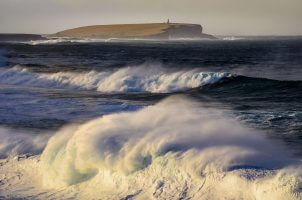Support Hidden Compass
Our articles are crafted by humans (not generative AI). Support Team Human with a contribution!
Chiara Vigo sits behind a wooden desk covered in baskets of what appears to be brownish fur. The walls of the room are decorated with framed textiles, and an ancient-looking loom sits in the corner. Vigo is dressed entirely in black and wears her white-streaked, dark hair back in a tight bun. Without looking up, she lifts a glass jar containing a cloudy green liquid, takes a deep breath, and starts howling into it. A couple of onlookers watch in reverential silence, seduced by the demonstration. After a few moments, Vigo lowers the jar onto the desk again.
“There,” she says in Italian, her eyes large behind her thick red glasses as she looks up at her audience. “Now it can capture light.”
Vigo reaches into the jar, pulls out what looks like a hairball, squeezes out the remaining liquid, and then stands to let us touch it. Compared to the brown fur in the baskets, this material now has a golden-copper sheen. She moves from person to person with practiced experience, pinching the hairball between her long nails to put it into the next outstretched hand.
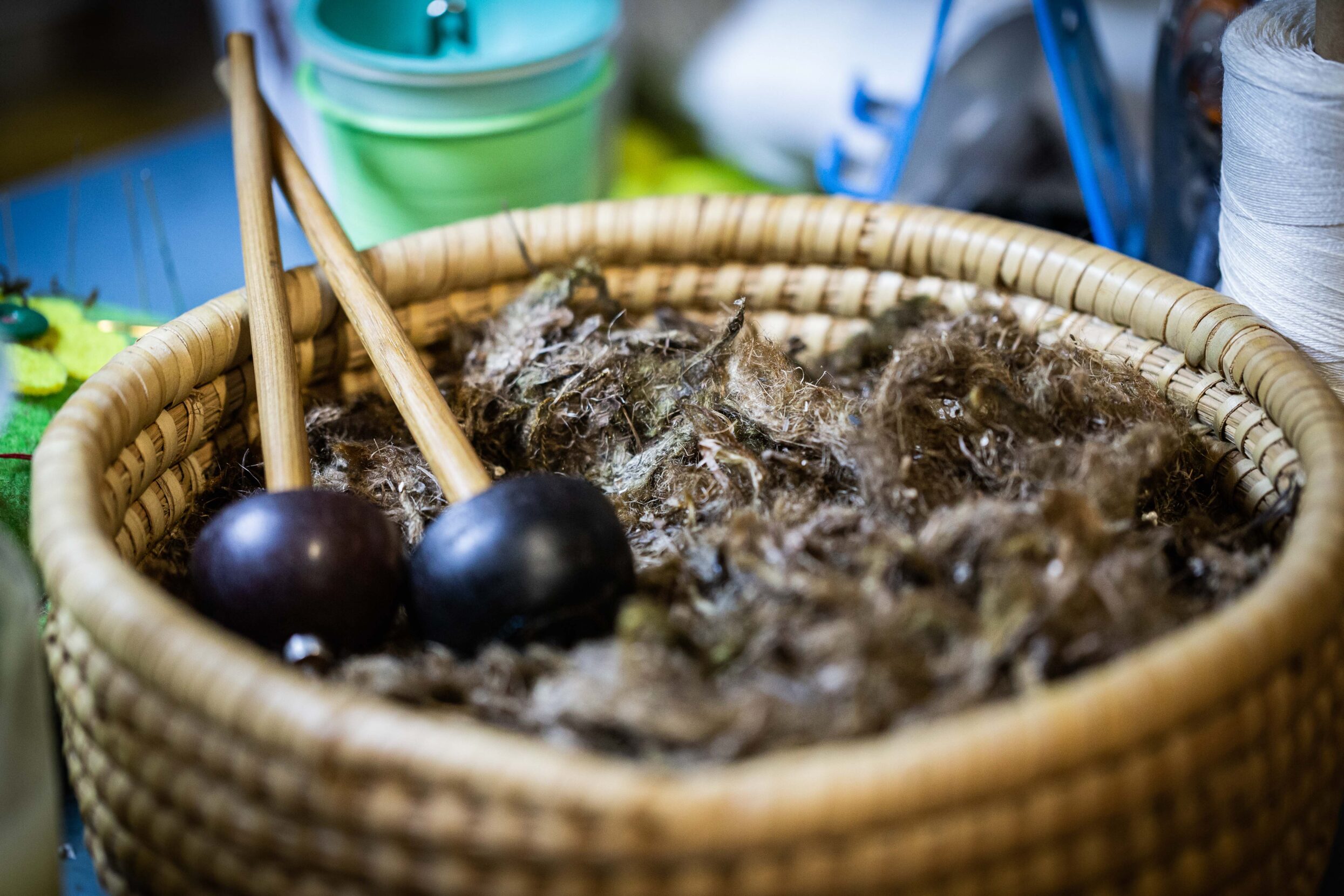
Tufts of Pinna nobilis byssus await their transformation to bisso — an ancient thread and textile steeped in myth, whose price was once comparable to that of gold. Photo: Fabrizio Schirru.
This brilliant material is made from Pinna nobilis, the noble pen shell clam. Reaching lengths of up to four feet, P. nobilis is the largest clam in the Mediterranean Sea. These giant, endemic mollusks anchor themselves to the seafloor with long adhesive fibers — byssus, also known as sea silk.
Many mollusks produce byssus, but only the P. nobilis’s has been collected, treated, and spun into magnificent golden thread – bisso – since antiquity. And only P. nobilis has unraveled into a critical cultural and environmental crisis in the Mediterranean. I can feel its precariousness sitting in the corners of the room even as Vigo places the luxuriously light and feather-soft clump of byssus in my palm.
~~
I’ve been coming to the tiny Sardinian island of Sant’Antioco for most of my life. My parents were entranced by its turquoise waters, small-town feel, and — I suspect — the primordial history and heritage that breathes with every crash of a wave and gust of wind. Bisso is an important part of that allure.

Sant’Antioco is small Sardinian island with millennia of rich history. For journalist Margherita Bassi, it is also a familiar place. Photo: M. Kuehn / Alamy.
According to Vigo, legend has it that it was the Chaldean Princess Berenice who, as punishment for falling in love with the Roman Emperor Titus, was exiled here, where she taught the locals how to turn byssus fibers into the thread and textile they now call bisso.
“The material is so rare that it has hardly, or not at all, been mentioned in textile history,” Dr. Felicitas Maeder from the Natural History Museum in Basel, Switzerland, explained to me. Over the last three decades, she has researched and compiled what seems to be the only comprehensive digital resource on the history of sea silk. P. nobilis have been well known since antiquity, but what we don’t know is when the clam’s byssus started being used.
“At some point, somewhere, someone had the idea to use not only the animal — it was an everyday food — but the adhesive threads from the Pinna nobilis as well,” she added.
Eventually, the price of byssus thread was comparable to that of gold, as it was likely used to make luxury garments. Some even argue that the golden fleece the Greek hero Jason chased across the world with his fleet of Argonauts was made of bisso.
“This precious fiber had seduced everyone at the time.”
Though Maeder says the craft of bisso probably came from the Phoenicians, we don’t actually know how large the sea silk trade was at any point or where, exactly, it was produced. Only Taranto and Sardinia have been proven, without a doubt, as historical production centers. But somewhere along the way, the ancient reverence was lost.
This art now hangs by a thread: There are few practitioners left, and P. nobilis, decimated by a parasitic outbreak, grows ever closer to extinction. Against this backdrop, the remaining weavers of bisso are scrambling to ensure the tradition lives on, but they’re going about it in strikingly different — and often conflicting — ways.
~~
Today, the town of Sant’Antioco — where Vigo lives and which takes its name from the island it was founded on — is an ancient windswept community of less than 11,000 inhabitants.
Back in her studio, Vigo hooks the hairball onto a spindle and rolls it off her thigh to start spinning the fiber into glittering thread. The process has already been arduous. Byssus is collected by hand. Then Vigo soaks it in fresh water for 25 days, changing the water every three hours. Next, she uses lemon juice to lighten its color and submerges it in a proprietary liquid that includes 15 different seaweeds to make the fibers more elastic. Finally, she spins it with a strictly juniper spindle.
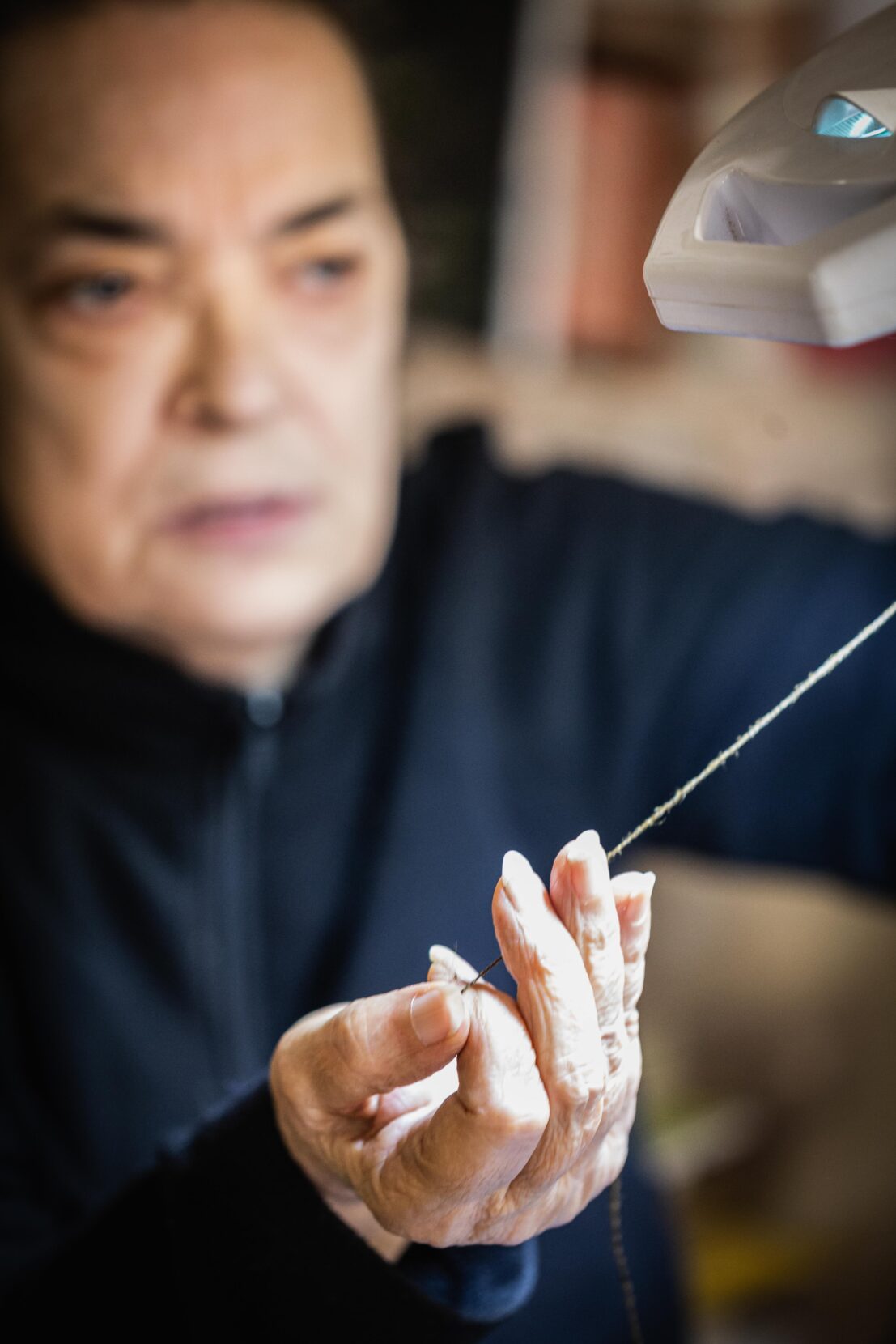
Chiara Vigo displays spun bisso thread under lamplight. Her bisso work and efforts to preserve the ancient craft are world renowned. Photo: Fabrizio Schirru.
If you’ve heard of bisso, chances are it’s because of Chiara Vigo. She’s become a local celebrity for bringing international attention to this ancient tradition practiced in a forgotten corner of the Mediterranean. If you search “bisso,” “byssus,” or “sea silk,” her name pops up everywhere. She’s been interviewed by top publications, and in her small museum that morning, I watch alongside foreign tourists clearly under the spell of both the craft and the older woman channeling the artistry of ancient civilizations.
When Vigo tugs the long thread off the spindle and lets us pluck it like a guitar string, it feels infinitely softer than yarn against the tip of my index finger. Then she angles the thread in front of her lips as one might hold a flute and hums deeply. Her voice reverberates through the cluttered room.
The sound treatment — including the earlier howling — makes the thread glow like gold, Vigo says. It’s a process she calls “sonification,” and, apparently, a professor from La Sapienza University in Rome helped Vigo demonstrate it. That’s what she tells the audience.
Once the humming ends, she gestures for us to follow her to the doorway. The moment feels sacred — we stand in the cool shadows of the room while Vigo, who says she is the last living bisso master, steps into the light streaming in from the open door. She lifts the thread toward the sun like a prophet presenting a gift from the heavens. The fibers glisten like liquid gold in the warm light. Moments later, she chants the names of 28 women in a single breath: According to her, these are 28 generations of bisso masters in her family who made a promise to dedicate their lives to sea silk. It’s hard to resist her spectacle.
~~
On the Spanish Mediterranean coast back in 2016, a parasite called Haplosporidium pinnae was discovered, its origins unknown. Attacking P. nobilis, the parasite colonizes the mollusk’s digestive system and prevents it from closing its shell, rendering it defenseless in the face of predators and water pollution alike. In the last eight years, it has infected P. nobilis populations in France, Tunisia, Italy, Malta, Greece, Cyprus, and Turkey, causing mass mortality events with a death rate of up to 100% in some areas.
In response, in 2019, the International Union for Conservation of Nature and Natural Resources (IUCN) listed P. nobilis as critically endangered.
But the threats to P. nobilis aren’t limited to H. pinnae. Though it has been illegal to harm or harvest P. nobilis in Europe since 1992, harvesting, trawling, anchoring, invasive species, environmental pollution, and the regression of seagrass meadows — the clam’s natural habitat — are all contributing to the clam’s decline.
“I am very angry,” Vigo says fervently, “because if the species is risking extinction, but here we still have some live ones, can someone tell me why this archipelago hasn’t been declared a protected marine zone?”
She makes a good point, and I follow up by asking her how much byssus she has collected in her lifetime. She immediately becomes defensive and repeats that the question we should be asking is how to make a protected marine environment. Her onlookers nod in silent agreement. She then adds that she has inherited enough sea silk from her grandmother and great-grandmother to last her another ninety years — why would she have to collect any?
But I know this is untrue even while I sit before her, watching her capture more golden light in that feathery, coppery thread. Many of the publications that have spread her fame have also spread pictures of her diving to collect byssus every spring, well into her early 60s.
How do we safeguard an ancient textile tradition that depends on an endangered species and a community fraught with division and misinformation?
I decide to change topics, and I ask Vigo if the young locals are showing any interest in the craft. Her answer is stern: “That’s not the right question. The question should be, are there any youth interested in upholding the oath of water?” That is what she calls the promise to dedicate one’s life to bisso.
She then laments the internet, full of people “who are masters all of a sudden.”
“Those who don’t have a previous history come from nowhere and will go nowhere,” she says bitterly, returning to her seat. “Imagine becoming a master and then finding someone who writes that they make bisso from Japan? That’s not the tradition; that’s not bisso.”
The comment seems oddly specific. And I’m suddenly struck by the fact that Vigo might be dooming the very tradition she’s trying to save.
~~
During my time at Sant’Antioco, I learn that there are a lot of people on the island outraged at the attention Vigo has received over her claims — both of her long lineage of bisso weavers and of being the last remaining master of bisso.
Her “sonification” treatment is an element frequently called into question, so I reach out to the La Sapienza University professor she claims proved its effect.
Professor Fucile confirms to me that he did record greater fluorescence in the fibers that Vigo treated as opposed to those she didn’t, but he also specifies that the treatment included submerging the byssus in a particular solution in addition to the “sonification.” He thinks that it was the acidity of the solution, not her voice, that heightened the fiber’s ability to reflect light like gold.
Dr. Anne Sicken from the Cologne Institute of Conservation Sciences also tells me that the idea of sound treatment is “nonsense,” and confirms that the lemon juice or citric acid causes a brightening of the fiber’s natural color.
~~
After meeting Vigo, I decided to go see the giant clams for myself — to get a sense of the ancient creature at the root of such history and contention on this island. But when I ask where I might find them, the responses are immediate and bleak:
“They’re all dead,” someone tells me.
“You’d need a time machine,” someone else says. “Fortunately, there are still some, I know where, but I will never say, even under torture!”
Walter Marcia, a thin, Vespa-riding older man even brings me to the deserted beach where he and his siblings harvested P. nobilis in their youth. The beach’s sands are shockingly blue, covered in millions of small jellyfish-like creatures called velellas that frequently wash ashore in the spring. As we walk, he recounts how they’d grab hold of the clam’s briny curves, brace their feet against the sand, and then yank upwards until the fiber anchors ripped, and they could swim back to the surface with their prize. He remembers prying them open in search of pearls and then eating the mollusk fried.
“They were so big,” he told me, spreading his arms vertically to show me just how large. “Now, there is a disease that is killing them.”
I begin to realize that I may never see P. nobilis in these waters.
But then, I meet Dominika Kucal, the co-founder of Sirena Sardinia Diving School in Sant’Antioco, who offers to take me snorkeling in search of the giant clams.
She drives us to a forgotten stretch of coast that most people just drive by, with a narrow strip of sand backed by a wall of reeds and a couple of small, abandoned boats bobbing in the water.
We wiggle into our wetsuits and pad across the poorly paved road before hopping over the divider. After spitting in our snorkeling masks, adjusting our snorkels, and slipping on our flippers, we walked backward into the frigid, early April sea.
Dominika and I swim slowly through the shallow blue-green water with our eyes glued to the seafloor, weaving through long-forgotten anchor lines and hoping to catch sight of a giant clam sticking out of the seaweed meadows. We swim for some time before Dominika gestures energetically toward the sandy bottom, where a thin, hairy stone sticks out of the seafloor. Of course, it’s not actually a stone. I move to look at it from another angle and finally recognize it for what it is: a P. nobilis.
It’s smaller than I expected, and I’m hit with the somewhat silly thought that it looks terribly lonely all by itself. We float above it for a couple of moments, then after taking a moment to marvel at the sight, I give Dominika a thumbs up. She snaps some pictures with her GoPro, and we keep searching. Over the next half hour we only spot a couple more, and most of them are on their sides, which Dominika later explains means the clams are dead. It’s terrible to think that the area was once full of them.
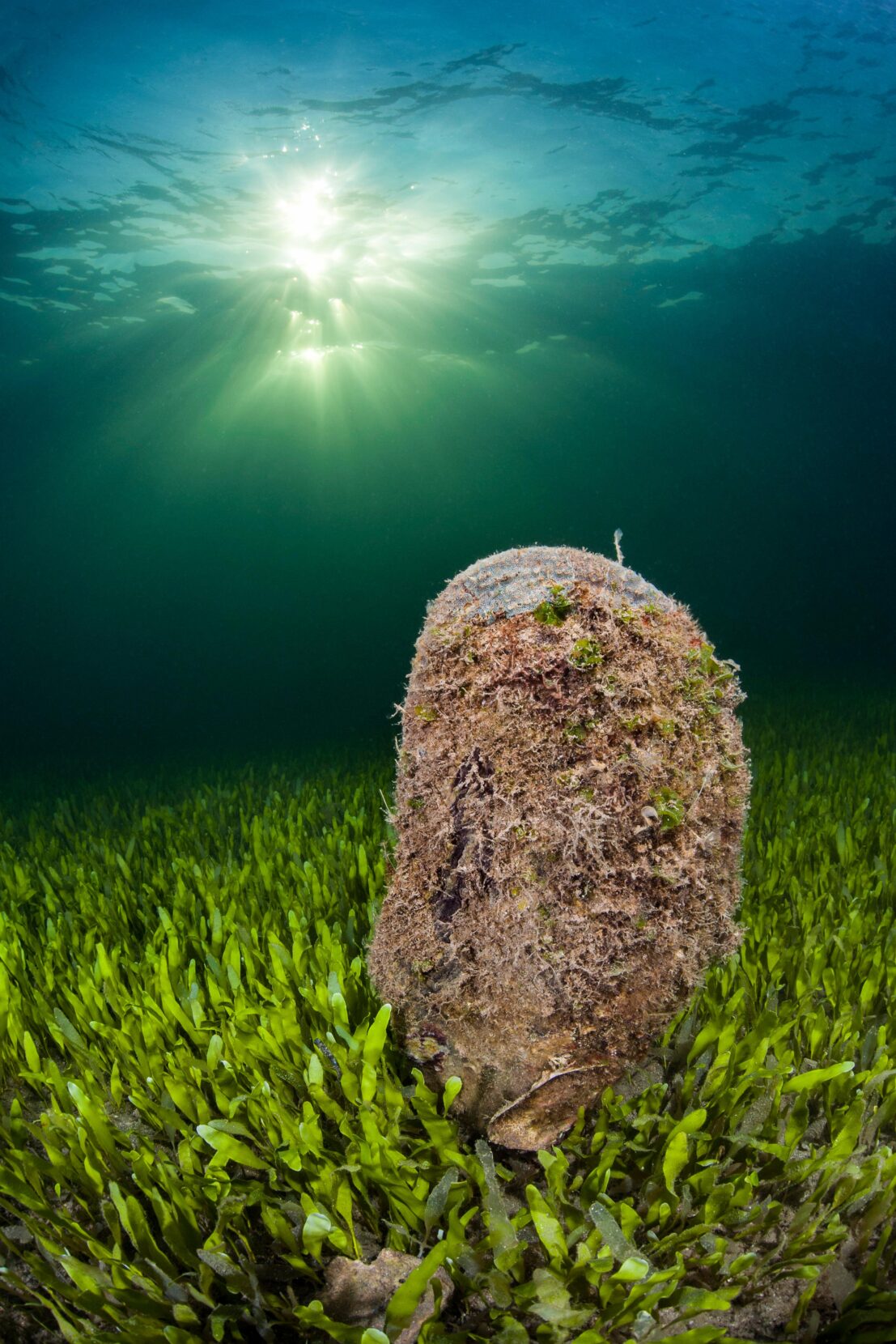
A lone P. nobilis sticks out from a seaweed meadow off the coast of Sant’Antioco. Once abundant in these waters, the species has been ravaged by a parasite. Photo: Alex Mustard / Alamy.
~~
Three months after meeting Vigo, I walk into Giuseppina and Assuntina Pes’s weaving studio — a dynamic room with bright yellow walls covered in framed pictures and textiles, with a large loom on the left. It reminds me of Vigo’s studio, but only at first glance. The Pes sisters welcome me in a more intimate and less ostentatious manner. It’s just the three of us and their intern, a young Belgian woman working quietly at the loom.
The Pes sisters don’t claim to descend from many generations of bisso makers, but they do feel firmly rooted in the history of the ancient craft. After a precipitous decrease in bisso activity in the 19th century, it took a man named Italo Diana to revive the art. In the 1920s, he opened a school in Sant’Antioco to teach the town’s women spinning, weaving, and embroidery. His own work with bisso became well known beyond the tiny island, and he passed the tradition on to many of the local women.
The Pes sisters see themselves as the legacy of Diana’s teachings, and they are more than happy to tell me about his work. I quickly realize that where Vigo tempts tourists with myth and legends, Giuseppina and Assuntina convince them with scrupulous bookkeeping and education.
Giuseppina tells me that in Diana’s lifetime, the Sant’Antioco lagoon was full of P. nobilis. The giant clams grew abundantly, and the locals seemed to use every part of the animal except for its bushy fibers. The shell was carved into buttons and ornaments, and the mollusk was eaten like steak.
After hearing about the quasi-lost art of bisso, Diana experimented with spinning the soft material. He began teaching his students and earned recognition for his work and education — eventually reviving the practice.
“This precious fiber had seduced everyone at the time,” Giuseppina adds.
One of Diana’s students was Efisia Murroni, a woman the sisters met in the 1990s.
“She showed us bisso, and our eyes went wide!” Giuseppina laughs.

Before it is spun into thread, the feather-light fibers of P. nobilis byssus, which is already softer than other byssus, is treated to lighten the color. Photo: Giulio Gigante / CC BY-SA 2.0.
Murroni taught Giuseppina and Assuntina everything she’d learned from Diana and even gave them some of the byssus he’d passed down to her.
“[Bisso] is something you can’t find anywhere else,” Giuseppina says reverentially, “but here it’s still alive.” She puts a tuft of soft, copper-colored byssus in my palm. Its airy touch and infinitely light weight has started to feel familiar.
“This is Master Diana’s byssus,” Assuntina says proudly, “It’s over one hundred years old.”
In my other hand, they place a clump of byssus from a regular mussel for me to compare. The difference is shocking — the fibers are coarse and gray, while the P. nobilis’s reflect light even pre-treatment and are as soft as down.
Years later, the Pes sisters met Diana’s daughter Emma, who liked their work and rewarded them with a huge quantity of byssus she’d inherited from her father.
“She put the history of our town in our hands,” says Giuseppina.
I later find a picture of a younger version of the sisters grinning next to an older woman carrying a giant basket of the light brown fibers, immortalizing the immense donation.
To this day, Giuseppina and Assuntina say they have only worked with byssus that’s been donated to them — they’ve never collected it themselves. I’m surprised by this. It contrasts sharply with Vigo, whose dives for byssus are well documented online despite her defensiveness when I’d asked her about it directly. Everything that’s ever been donated to the Pes sisters — from byssus to the ultra-centenarian loom — has been carefully recorded in writing, along with the signatures of all interested parties.
And where Vigo seems reluctant to train a new generation of bisso workers, Giuseppina and Assuntina have no qualms about spreading their knowledge. In addition to the intern they’ve taken under their wing, they often go to schools to teach students about byssus, letting them feel fluffy clumps of the material and showing them how to weave thread with a small loom. They don’t ask the children to take an oath, nor do they mention a mysterious seaweed potion needed to make byssus more elastic. When I ask whether they use sonification to treat the fibers, they look at me like I’m out of my mind.
I don’t mention Vigo directly, but when I ask them how they deal with the current tensions that exist around bisso, they know exactly what I’m talking about. Namely, that according to Vigo — and stories written about her — the sisters don’t exist.
“We don’t give importance to what other people say,” Giuseppina says. “We try to bring our tradition forward without causing drama.”
At the end of the visit, I ask them what they see for the future of bisso. The sisters remain vague. They imply the existence of “projects” with interesting potential and that, in the meantime, they’ll make their centenarian byssus last as long as possible. When I press them on the fact that it will eventually run out, Giuseppina suggests that maybe one day, we’ll be able to farm P. nobilis, and they might even repopulate the lagoon.
I’m disappointed they don’t give me more. In the moment, it feels naive to think mollusk farming will solve the problem. But then again, the sisters can’t single-handedly stop the human-made environmental threats to P. nobilis, nor can they pretend to know how to cure the parasite — if anyone did, we might not be here today.
~~
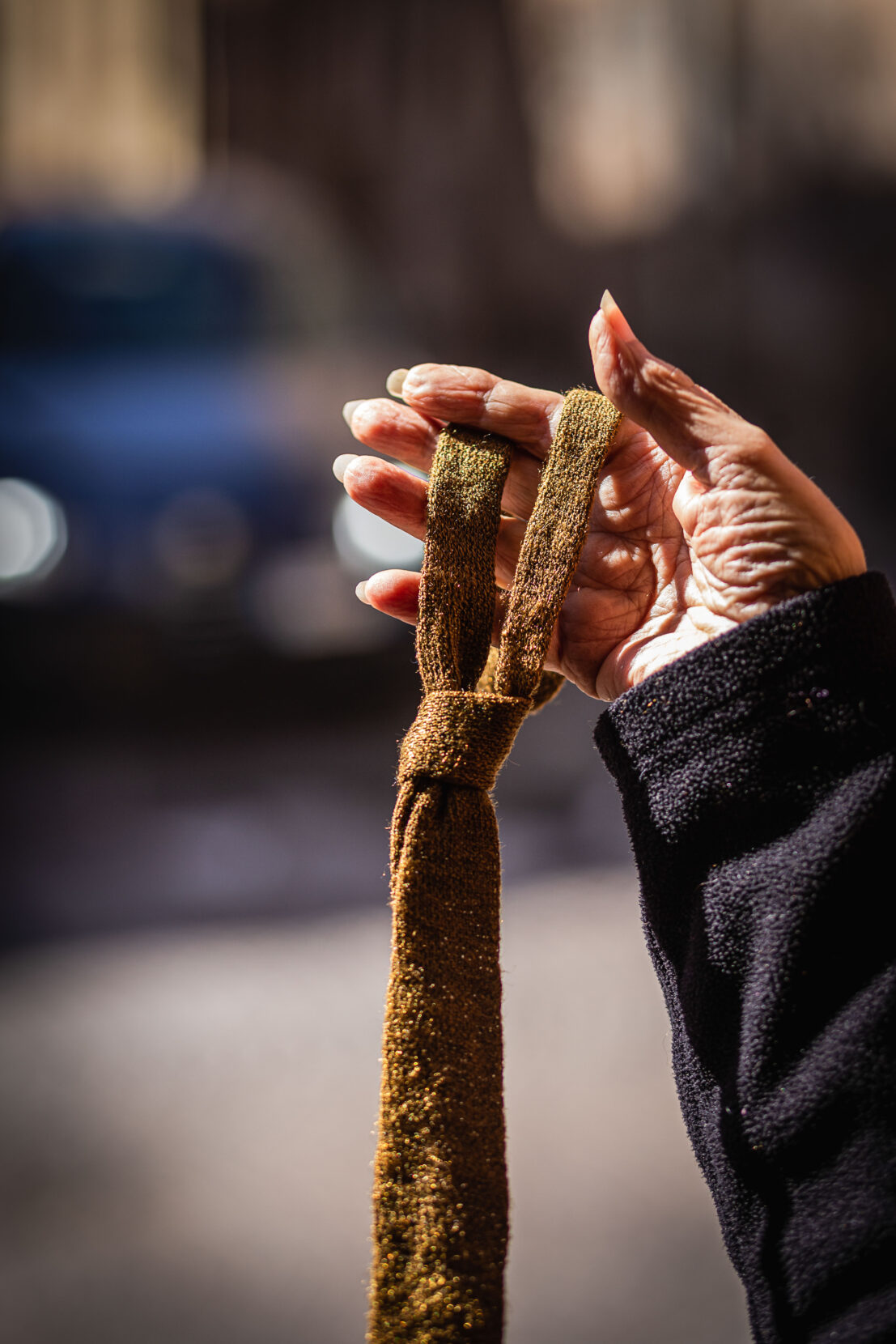
A bisso tie woven by Vigo. Sea silk, or bisso, was once likely used to make luxury textiles, including clothing. Today, the ancient art is imperiled by dwindling interest and environmental catastrophe, but some are working to ensure this unique craft lives on. Photo: Fabrizio Schirru.
People tend to believe traditions are unchangeable, but they’re more flexible than one might think. While Vigo despairs about insufficient environmental protections and a younger generation disinterested in becoming true “masters,” and the Pes sisters hope P. nobilis will be plentiful enough by the time they’ve run out of their centenarian byssus, there is another young woman forging an alternative path in this ancient craft — one rooted in adaptation.
Arianna Pintus lives in San Giovanni Suergiu, on the main island of Sardinia, but while researching the textile traditions of her ancestors’ homeland, she traced her origins back to the Island of Sant’Antioco.
“That was how I learned about byssus and how I fell in love with it,” she tells me in an email. But Arianna never collected any P. nobilis byssus, nor was any donated to her. Instead, about a decade ago, she decided to try using the byssus of a different clam: the oceanic Atrina pectinata. As opposed to P. nobilis, A. pectinata is still harvested in various parts of the world for its meat — a process that scraps its anchoring fibers as waste.
“Contrary to the byssus produced by other mollusks, which has no textile value, this filament is identical to that produced by our Pinna nobilis,” she tells me. “The only difference lies in its length.” The A. pectinata is a smaller mollusk than the P. nobilis, and so its byssus is shorter, too.
After a quick search, I realize that the A. pectinata also exists on Japanese coasts. Though I can’t confirm Vigo was complaining specifically about Pintus when she made her comment about byssus from Japan, the coincidence is hard to ignore.
Pintus, in fact, tells me that in the past, she has received demoralizing and hurtful criticism. But she has decided to seek perspective: “Over time, I have learned to give due weight to other people’s opinions, especially when they are baseless and aimed at distracting us from our intentions.”
When I ask Pintus what she sees for the future of bisso, she’s uncertain. She says that it’s of vital importance to pass on ancient know-how despite the fact that in the case of bisso there are environmental implications. But then she adds that there also isn’t room for jealousy when it comes to traditions, which shouldn’t become fetishes for one’s ego or “something that you keep for the sole purpose of feeling special and important, but that you don’t want to share with anyone.”
~~
On the last evening of my first reporting trip in Sardinia, I settled along the boardwalk to watch the Patron Saint procession for the 665th Feast of Sant’Antioco. Soon, the lungo mare street was filled with folklore troops in long flowing costumes either atop giant horses, playing instruments, or waving cheerfully at the crowd. It’s hard to believe that the island has been celebrating its beloved martyr for over six centuries. And it makes me ponder how some traditions are able to rally such timeless support while others are eventually forgotten.
Perhaps the economic benefits for local businesses during the festivities play an important role, but no such advantage exists for bisso. Vigo dramatically claims that those who have tried to make money from the craft have been cursed, but Pintus is more practical: “If bisso is exploited following the logic of the market, there is a risk of both environmental and cultural damage.”
That’s one thing Vigo, Pintus, and the Pes sisters all agree on: Bisso isn’t for sale.
I find myself continually attempting to unravel an ever-tangled question: how do we safeguard an ancient textile tradition that depends on an endangered species and a community fraught with division and misinformation? Bisso is in the hands of women like Chiara Vigo, the Pes sisters, and Arianna Pintus — one stuck in the allure of the past, two fixed in the ways of the present, and another marching toward the future. Their individual approaches are disjointed but their passion is real, and all bring something tangible to the fight for preservation.
For all her gatekeeping and ego, Vigo has made the world pay attention, and her fury toward a lack of environmental policy is deeply relatable. But her mythmaking and mysticism alienates younger generations who might otherwise show interest in the craft — interest that is vital to bisso’s survival. The Pes sisters, on the other hand, are quiet evangelists — perhaps too quiet — trying to preserve bisso through education and inspiring new artisans as they themselves were inspired in their teenage years. And, of course, there is Pintus, who might be the most forward-looking of them all. In the face of environmental catastrophe, she isn’t clinging to the letter of tradition as P. nobilis heads toward extinction. She’s forging a new path forward — adapting so that the art might live.
The conflicts between these approaches are significant, but threads from each are necessary. According to legend, it was passion and conflict that brought the art of bisso to Sant’Antioco in the first place. Perhaps it’s the combination of these same fiery emotions that will keep it here for another thousand years.
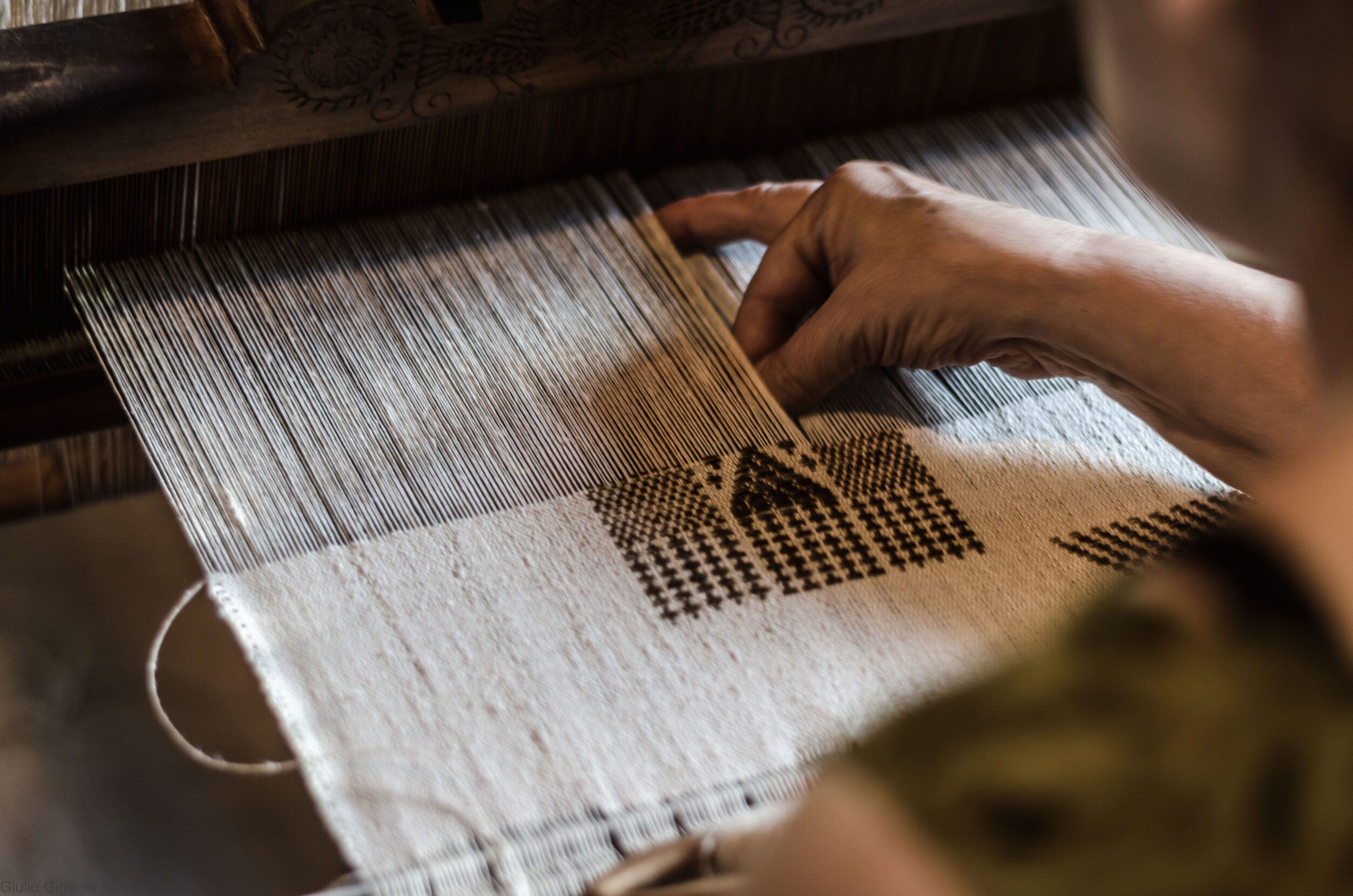
Vigo weaves at her loom. Bisso has survived since antiquity. If Vigo, the Pes sisters, and Pintus have their way, this art will be around for generations to come. Photo: Giulio Gigante / CC BY-SA 2.0.
Margherita Bassi
Margherita is a trilingual storyteller and writer with an insatiable love for reading, travel, and very old things.


